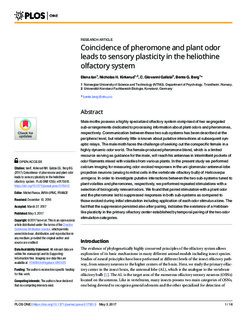| dc.contributor.author | Ian, Elena | |
| dc.contributor.author | Kirkerud, Nicholas Hagen | |
| dc.contributor.author | Galizia, C. Giovanni | |
| dc.contributor.author | Berg, Bente Gunnveig | |
| dc.date.accessioned | 2017-12-12T10:35:16Z | |
| dc.date.available | 2017-12-12T10:35:16Z | |
| dc.date.created | 2017-05-04T10:22:18Z | |
| dc.date.issued | 2017 | |
| dc.identifier.citation | PLoS ONE. 2017, 12 (5): e0175513. | nb_NO |
| dc.identifier.issn | 1932-6203 | |
| dc.identifier.uri | http://hdl.handle.net/11250/2470647 | |
| dc.description.abstract | Male moths possess a highly specialized olfactory system comprised of two segregated sub-arrangements dedicated to processing information about plant odors and pheromones, respectively. Communication between these two sub-systems has been described at the peripheral level, but relatively little is known about putative interactions at subsequent synaptic relays. The male moth faces the challenge of seeking out the conspecific female in a highly dynamic odor world. The female-produced pheromone blend, which is a limited resource serving as guidance for the male, will reach his antennae in intermittent pockets of odor filaments mixed with volatiles from various plants. In the present study we performed calcium imaging for measuring odor-evoked responses in the uni-glomerular antennal-lobe projection neurons (analog to mitral cells in the vertebrate olfactory bulb) of Helicoverpa armigera. In order to investigate putative interactions between the two sub-systems tuned to plant volatiles and pheromones, respectively, we performed repeated stimulations with a selection of biologically relevant odors. We found that paired stimulation with a plant odor and the pheromone led to suppressed responses in both sub-systems as compared to those evoked during initial stimulation including application of each odor stimulus alone. The fact that the suppression persisted also after pairing, indicates the existence of a Hebbian-like plasticity in the primary olfactory center established by temporal pairing of the two odor stimulation categories. | nb_NO |
| dc.language.iso | eng | nb_NO |
| dc.rights | Navngivelse 4.0 Internasjonal | * |
| dc.rights.uri | http://creativecommons.org/licenses/by/4.0/deed.no | * |
| dc.title | Coincidence of pheromone and plant odor leads to sensory plasticity in the heliothine olfactory system | nb_NO |
| dc.type | Journal article | nb_NO |
| dc.type | Peer reviewed | nb_NO |
| dc.description.version | publishedVersion | nb_NO |
| dc.source.pagenumber | 16 | nb_NO |
| dc.source.volume | 12 | nb_NO |
| dc.source.journal | PLoS ONE | nb_NO |
| dc.source.issue | 5 | nb_NO |
| dc.identifier.doi | 10.1371/journal.pone.0175513 | |
| dc.identifier.cristin | 1468057 | |
| dc.description.localcode | © 2017 Ian et al. This is an open access article distributed under the terms of the Creative Commons Attribution License, which permits unrestricted use, distribution, and reproduction in any medium, provided the original author and source are credited | nb_NO |
| cristin.unitcode | 194,67,40,0 | |
| cristin.unitname | Institutt for psykologi | |
| cristin.ispublished | true | |
| cristin.fulltext | original | |
| cristin.qualitycode | 1 | |

